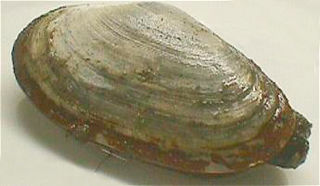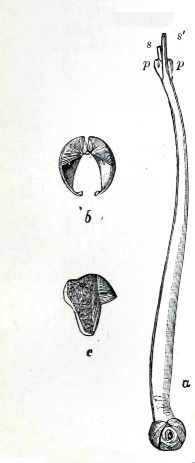
The shipworms are marine bivalve molluscs in the family Teredinidae: a group of saltwater clams with long, soft, naked bodies. They are notorious for boring into wood that is immersed in sea water, including such structures as wooden piers, docks and ships; they drill passages by means of a pair of very small shells borne at one end, with which they rasp their way through. Sometimes called "termites of the sea", they also are known as "Teredo worms" or simply Teredo, from the Greek τερηδώνteredōn, via Latin. Eventually biologists adopted the common name Teredo as the name for the best-known genus.

A scow is a type of flat-bottomed barge. Some scows are rigged as sailing scows. In the 19th and early 20th centuries, scows carried cargo in coastal waters and inland waterways, having an advantage for navigating shallow water or small harbours. Scows were in common use in the American Great Lakes and other parts of the U.S., in southern England, and in New Zealand. In Canada, scows have traditionally been used to transport cattle to the islands of New Brunswick's Saint John River. In modern times their main purpose is for recreation and racing.

A fluyt is a Dutch type of sailing vessel originally designed by the shipwrights of Hoorn as a dedicated cargo vessel. Originating in the Dutch Republic in the 16th century, the vessel was designed to facilitate transoceanic delivery with the maximum of space and crew efficiency. Unlike rivals, it was not built for conversion in wartime to a warship, so it was cheaper to build and carried twice the cargo, and could be handled by a smaller crew. Construction by specialized shipyards using new tools made it half the cost of rival ships. These factors combined to sharply lower the cost of transportation for Dutch merchants, giving them a major competitive advantage. The fluyt was a significant factor in the 17th-century rise of the Dutch seaborne empire. In 1670 the Dutch merchant marine totalled 568,000 tons of shipping—about half the European total.
In computer networking, Teredo is a transition technology that gives full IPv6 connectivity for IPv6-capable hosts that are on the IPv4 Internet but have no native connection to an IPv6 network. Unlike similar protocols such as 6to4, it can perform its function even from behind network address translation (NAT) devices such as home routers.

Ruth Dixon Turner was a pioneering U.S. marine biologist and malacologist. She was the world's expert on Teredinidae or shipworms, a taxonomic family of wood-boring bivalve mollusks which severely damage wooden marine installations.

In stream restoration, river engineering or coastal engineering, revetments are sloping structures placed on banks or cliffs in such a way as to absorb the energy of incoming water. In military engineering they are structures, again sloped, formed to secure an area from artillery, bombing, or stored explosives. River or coastal revetments are usually built to preserve the existing uses of the shoreline and to protect the slope, as defense against erosion.

Pouteria is a genus of flowering trees in the gutta-percha family, Sapotaceae. The genus is widespread throughout the tropical regions of the world. It includes the canistel, the Mamey sapote, and the lucuma. Commonly, this genus is known as pouteria trees, or in some cases, eggfruits.

Teredo navalis, commonly called the naval shipworm or turu, is a species of saltwater clam, a marine bivalve mollusc in the family Teredinidae. This species is the type species of the genus Teredo. Like other species in this family, this bivalve is called a shipworm, because it resembles a worm in general appearance, while at the anterior end it has a small shell with two valves which is adept at boring through wood.

Carl Gustaf Anders Franzén was a Swedish marine technician and an amateur naval archaeologist. He is most famous for having located the 1628 wreck of the Swedish galleon Vasa in 1956 and participated in her salvage 1959–1961. He also participated in the exploration for the wrecks of Swedish warships Kronan, Riksäpplet and Resande Man as well as Gustav Vasa's flagship Lybska Svan.

Myida is an order of saltwater clams, marine bivalve molluscs in the subclass Heterodonta. The order includes such bivalves as soft-shell clams, geoducks and shipworms.
Bankia is a genus of ship-worms, marine bivalve molluscs of the family Teredinidae.

Lyrodus is a genus of ship-worms, marine bivalve molluscs of the family Teredinidae.
Kuphus is a genus of shipworms, marine bivalve molluscs in the family Teredinidae. While there are four extinct species in the genus, the only extant species is Kuphus polythalamius. It is the longest bivalve mollusc in the world, where the only known permanent natural habitat is Kalamansig, Sultan Kudarat in the Philippines.

Teredo is a genus of highly modified saltwater clams which bore in wood and live within the tunnels they create. They are commonly known as "shipworms," and are marine bivalve molluscs in the taxonomic family Teredinidae. The type species is Teredo navalis.
Teredora princesae is a species of marine bivalve mollusc in the family Teredinidae, the shipworms. This species lives in timber that is floating in the western Pacific Ocean.

Piling foundations support many historic structures such as canneries, wharves, and shore buildings. The old pilings present challenging problems during restoration as they age and are destroyed by organisms and decay. Replacing the foundation entirely is possible but expensive. Regularly inspecting and maintaining timber piles may extend the life of the foundation.
Lithoredo is a genus of shipworm native to the Abatan River in the Philippines. It contains a single species, Lithoredo abatanica, described in June 2019. The species is unusual because, unlike other shipworms which mainly bore into wood, it tunnels into and excretes limestone. It lacks the cecum which in other shipworms holds symbiotic bacteria which digest wood. Lithoredo have differently shaped teeth than shipworms which can finely grind stone. The worms use the tunnels to live in but their method of eating is not yet known. They may get nutrition from bacteria in their gills.
Thiosocius is a genus of bacteria that lives in symbiosis with the giant shipworm Kuphus polythalamius. It contains a single species, Thiosocius teredinicola, which was isolated from the gills of the shipworm. The specific name derives from the Latin terms teredo (shipworm) and incola (dweller).
Kuphus polythalamius is a species of shipworm, a marine bivalve mollusc in the family Teredinidae.










